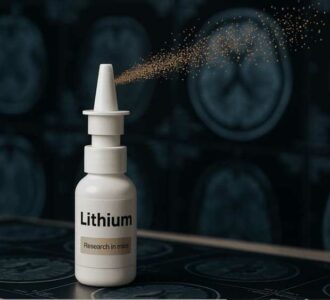 Nasal Spray with Gold Nanoparticles: A New Era in Brain Therapy
Nasal Spray with Gold Nanoparticles: A New Era in Brain Therapy
Publication Date: October 15, 2025
Published by MACKGOLD | OBSIDIAN CIRCLE
Strategic Department of Geopolitics and Natural Resources
www.mackgold.com
A scientific breakthrough by Italian researchers from the Università Cattolica del Sacro Cuore and the clinical center Fondazione Policlinico Universitario A. Gemelli IRCCS is already being hailed as one of the most significant innovations of the decade in the field of neurotechnology and nanomedicine. The scientists have developed a unique drug delivery system to the brain using gold nanoparticles carrying lithium ions. This is not merely a laboratory concept but a tangible, patented technology, already published in the journal Advanced Materials.
The core of the innovation lies in administering lithium—a well-known psychotropic drug used in the treatment of bipolar disorder and a range of neurodegenerative conditions—not orally, but intranasally, in aerosol form. In its conventional tablet-based form, lithium is effective but highly toxic when used long-term. It can cause kidney and thyroid damage, and the therapeutic window between benefit and harm is extremely narrow. The new method allows the drug to be delivered directly to the brain, bypassing systemic circulation, thereby dramatically reducing risks and enhancing targeted efficacy.
The key to this technology is gold nanoparticles approximately two nanometers in diameter. Gold was not chosen arbitrarily: it is biocompatible, chemically stable, and capable of transporting ions without disrupting cellular structures. The nanoparticles are coated with a biocompatible glutathione-based shell, enabling them to penetrate the mucosal membranes and cross the blood-brain barrier. Once inside the brain, the particles release lithium locally, where it inhibits the enzyme GSK-3β—a major factor in the development of Alzheimer’s disease, bipolar disorders, and viral neural infections.
Animal model studies have shown remarkable results. In mice with Alzheimer’s-like pathology, intranasal delivery restored memory, improved cognitive responses, and reduced levels of phosphorylated tau protein—a key biochemical marker of neuronal degeneration. Moreover, no elevated lithium levels were detected in blood plasma, confirming the localized nature of the treatment. No signs of inflammation, toxicity, or gliotic activation in the brain were observed.
Physiologist Roberto Piacentini and chemists Antonio Buonerba and Alfonso Grassi, who led the project, emphasize that the new technology reproduces all the beneficial effects of lithium at doses ten times lower than standard ones. It opens the door not only to treatment but also to prevention—especially of Alzheimer’s disease and other pathologies linked to GSK-3β dysfunction. Furthermore, the method can be adapted for the delivery of other drugs to the brain: antiviral, anti-inflammatory, and antipsychotic agents.
The nasal administration route, chosen by the researchers, represents one of the most promising directions in contemporary pharmacology. The nasal mucosa has direct communication with the central nervous system through the olfactory tract, enabling it to bypass the blood-brain barrier—one of the main obstacles to most drugs. The use of gold as a carrier renders the process both controllable and predictable: the metal is stable, non-reactive with enzymes, and capable of retaining therapeutic agents for extended periods.
This discovery not only expands the horizons of medicine but also demonstrates how noble metals are transitioning from jewelry showcases into vital technological domains. Whereas gold was once associated solely with luxury and economic value, today it emerges as a tool of precision neurotherapy. Its atomic structure, reflective properties, and chemical inertness make it an ideal intermediary between pharmacology and physiology.
In the coming years, the Università Cattolica team plans to complete preclinical trials and advance to clinical testing in humans. Parallel research is ongoing into expanding the applications of gold-based nanocarriers—particularly for treating viral encephalitis and the long-term effects of herpes infections, which recent studies have linked to dementia onset.
This field is already being described as the dawn of a “golden age of neuromedicine,” where gold is no longer a metaphor but a material of the future. It is quite possible that this metal—long a symbol of power and wealth—will now become a symbol of restored memory and preserved consciousness.
